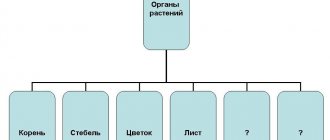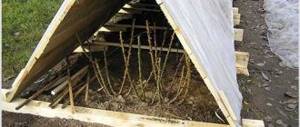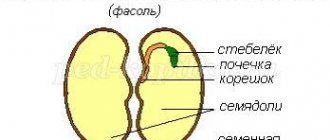Lesson “How do plants live?”
Open lesson summary
Teacher: Kuznetsova Elena Viktorovna
Class: 1
Lesson: the world around us
Date: 12/15/2019
Topic: How do plants live?
Objectives: to introduce the living conditions of plants; expand ideas about the life and growth of plants; show basic techniques for caring for indoor plants; cultivate a caring attitude towards plants.
Planned outcomes: students will learn techniques for caring for indoor plants.
Equipment: multimedia presentation (computer, screen), indoor plants, water for watering plants, items necessary for caring for indoor plants (watering can, diffuser, rags, stick for loosening the soil).
Visual material: “daisy” made of paper with the inscription “A plant is a living being”, pictures of “seeds, sprouts” with inscriptions, students have : circles (red, green, yellow), cards “What do different plants have in common?”, emoticons.
During the classes:
I. _ Organizing time.
— Hello, young nature lovers. I am glad to welcome you to the lesson! Let's greet each other (claps).
II . Preparation for work at the main stage.
- Guess the riddle and find out what we will talk about today in the lesson about the world around us.
He breathes, grows, but cannot walk. (plant)
— What will we study in class?
— Lesson topic: “How do plants live?” (slide 1)
— Do you think plants are alive?
— Do you need to take care of your plants?
— What goals will we set for ourselves?
Goals: learn that plants are living. We will learn how to care for indoor plants.
— Today in class I invite you to become researchers. This means we need to listen carefully, think, reflect, remember, speak out, and then we will complete all the assigned tasks.
— We will plant each question in the lesson in the ground like a seed, water it with our knowledge and skills so that the seed will germinate. If we answer this question, we will get a young sprout, and if we cannot, then the grain will die in the ground.
— Let’s not let the grains go to waste? Then be attentive and active.
III . Updating knowledge.
- Remember what you already know about plants? (Slide.)
— What do all plants have in common?
— We plant the first seed.
Work in pairs. (The children have cards : an illustration of a pea with well-defined parts of the plant and their names)
Exercise:
- Connect the parts of the plant with their name with lines. (students work with cards).
- So our seed has sprouted. (1 sprout)
- Let's read the main words.
Conclusion: What do all plants have in common?
— Check if you completed the task correctly? (slide 2)
- Evaluate the work in pairs (emoticons: yellow - they did everything correctly, green - they made a mistake, red - they didn’t cope with the task).
IV . Assimilation of new knowledge.
Creating a problem situation:
1) There is a picture of a chamomile on the board . B. There are question marks on the petals, and plant characteristics are written on the back of the petals.)
- Guess the riddle:
In the sister’s meadow there is a yellow eye and white eyelashes. (daisies)
— There’s one daisy sister in our lesson. (I open the daisy)
- Let's read the inscription on the daisy. Do you agree with this statement? Justify your answer.
- How can one prove that plants are alive?
- So the second grain fell into the ground. Let's help it grow.
— What do we need to do?
- Recall the characteristics of plants and identify those properties that allow them to be classified as living beings.
— What did you learn from studying the drawings?
- Look, the second seed has sprung!
Generalization: A plant grows, develops, eats, breathes, reproduces, dies. A plant is a living being.
- Well done!
2) – We have proven that the plant is a living being. Then the next question arises: What does a plant need to live?
— We plant the third seed. He also really needs your knowledge, skills and effort.
—Who knows how plant life begins?
- Look, you brought sprouted wheat and pea seeds.
— What changes have occurred?
— The seeds have sprouted in the plate.
— What influenced the seeds to begin to germinate? (water, heat)
— Where do plants get water and heat from in nature? (water from the rain, heat from the sun.)
— If the seeds remain in the jar, will the plant be able to develop? (No).
- Why? What should be done with sprouted seeds? (The seeds need to be planted in the ground.)
— If we plant sprouted seeds in a box, where should we put it?
- Why? What else do plants need? (light, air)
—What is necessary for plant life?
— The third sprout, with your help, reaches towards the light.
Conclusion: To live, plants need: water, heat, light, air, soil.
- Well, one more condition - careful attitude on the part of the person.
V. _ Facial minute for the eyes (slide)
VI . Consolidation of new knowledge and methods of action.
1. Observation of plant development. (using oak as an example)
— How does a plant develop?
-What plant do you see? (slide)
— Guess the riddle: An oak tree hid in a golden ball. (acorn)
Work according to the textbook on p.70.
Work in pairs.
— Consider how the life of an oak tree begins with an acorn. (silently, just demonstrate planting the 4th seed)
- Now look at the slide.
— Oak is a symbol of power and longevity. Oaks are long-lived. The lifespan of an oak is up to 1500 years, the tree reaches a height of 30 and even 40 m, bears a powerful crown, develops a thick trunk, the diameter of which often reaches 1-1.5 m. It is no coincidence that when they talk about something especially durable, strong , powerful, they use the comparison with an oak tree.
— Where does the life of an oak tree begin? (Sprout 4: “seed is a mature plant”)
2. Practical work.
1) Conversation.
- Every living thing requires care. Plants also love to be looked after.
— Who has indoor plants at home?
— Who takes care of your indoor plants at home?
- Are you helping? What are you doing?
— How to properly care for plants? (5 sprouts)
—Another grain asking for our help? Shall we help?
2) Familiarization with the memo “Rules for caring for indoor plants.”
- Water your plants with water at room temperature. In addition, the water must sit for several hours. In summer, flowers are watered in the evening, in winter - in the morning.
— It’s better to water flowers from a watering can. You can pour water directly into the pot, or into a tray. Do not raise the watering can high to avoid splashing water.
— So that the water passes to the roots of the plant and does not stagnate, the flowers should be loosened.
- Loosen the surface of the soil in the pot with a stick so that air can flow to the roots. Be careful not to damage the roots of the plant.
— Flowers love water treatments.
- Wipe dust from large, smooth leaves with a damp cloth or sponge.
- Hold the sheet from below with one hand and carefully wipe with the other.
Plants with small leaves and pubescent leaves are cleaned of dust with a soft brush.
— Many flowers love spraying.
— Why do you need to wipe the leaves of plants? (this is how plants breathe)
- Carefully remove dry leaves and twigs from plants. Keep flower pots and stands clean.
— Plants need sun, air and water to live. Some plants like a lot of light, while others do not. Therefore, they are located differently in the room: some on the windowsill, others away from the window.
(I hand out reminders to the children)
3) Work in a group.
- Choose a captain in your group. The captain will assign responsibilities. 2 people wipe the leaves, 2 people loosen the ground, and 1 person waters the flower. Follow all rules.
- Well done! With your efforts, you helped so many seeds sprout new sprouts and gave life to new plants.
IX . Information about homework.
- And at home you will glue them.
X. _ Summing up the lesson.
- In today's lesson, children, you were researchers and looked for answers to questions.
— Do you think we were able to find answers to the questions?
XI . Reflection.
— Evaluate your achievements in class. (emoticons)
— You have emoticons on your desks, choose the one that reflects your activities in the lesson. (Children choose the appropriate emoticons and raise them)
- Who made the discovery for themselves?
- Who can say for themselves, I worked actively in class!
— Who was interested in the lesson?
— Who did the lesson give you a good mood?
1
Lesson No. 28. “How do plants live?”
Film manual for lesson development “The World Around us” 1st grade
Lesson type:
combined
Target
the formation of ideas about the signs of living nature and the conditions necessary for the life of organisms; familiarization with the simplest rules for caring for indoor flowers
Planned results
Subject
Will learn:
observe the growth and development of plants; name the stages of plant life; know the conditions necessary for plant life; care for indoor plants.
Metasubject
Regulatory:
choose actions in accordance with the task (caring for indoor plants) and the conditions for its implementation, anticipate the result, and establish whether the result corresponds to the set goal.
Cognitive:
make assumptions and prove them; work in pairs, observe plants and talk about their observations; draw conclusions based on analysis of illustrations.
Communicative:
formulate your own opinion and position, your difficulties; determine a common goal and ways to achieve it; evaluate your achievements in class
Personal results
Show interest in objects of the surrounding world; treat the values of nature with care; understand your responsibility for the state of nature.
Basic concepts and definitions
A plant is alive, grows, develops, bears offspring, it needs water, heat, air, light.
Preparing to learn new material
Let's make sure that the plants are alive. We will learn how to care for indoor plants.
Remember what parts the plant consists of. Tell us (based on your observations) how plants are born, how they grow and develop.
Learning new material
How do plants live?
Look at the pictures and answer the questions. Draw a conclusion about what plants need to live.
1.Why do you water indoor plants?
2.Why are indoor plants placed close to the window?
3. What is the girl doing and why? 4. What happened to this plant? Why?
Practical work.
Learn how to care for indoor plants (watering, wiping leaves, loosening the soil).
The plant is alive. It grows, develops, bears offspring. Every plant dies someday. But many plants live a very long time. Plants need water, air, light and heat to live.
1.Prove that the plant is alive. 2. What do plants need to live?
3. How should you care for indoor plants?
How
plants
live Plants
are also living beings
Educational film “Development of a plant from a seed ”
Plant growth in 2 minutes .
Animation of
tree
growth Forest over a year. fast motion
Comprehension and understanding of acquired knowledge
Independent application of knowledge
Information sources
:
A. A. Pleshakov textbook, workbook The world around us, grade 1 Moscow
"Enlightenment" 2014
YouTube
website : https://www.youtube.com/
Hosting of presentations
around the world
- https://ppt4web.ru/nachalnaja-shkola/prezentacija-k-uroku-okruzhajushhego-mira-vo-klasse-chto-takoe-ehkonomika.html








